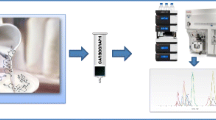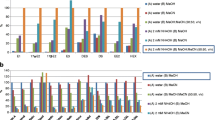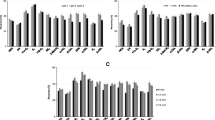Abstract
There have been many analytical methods for natural estrogens in commercial dairy milk samples, but in most of which, only four major estrogens (estrone (E1), 17β-estradiol (E2), estriol (E3), and 17α-estradiol (αE2)) were included. This work developed an effective GC–MS analytical method for simultaneous analysis of twelve natural estrogens in commercial dairy milk sample, in which eight far-less well-known natural estrogens (2-hydroxyestone (2OHE1), 4-hydroxyestrone (4OHE1), 2-hydroxyestradiol (2OHE2), 4-hydroxyestradiol (4OHE2), 16-epiestriol (16epiE3), 16α-hydroxyestrone (16αOHE1), 16-ketoestradiol (16ketoE2) and 17epiestriol (17epiE3)) were included besides the four major natural estrogens. With liquid–liquid extraction and solid phase extraction, twelve natural estrogens in commercial dairy milk could be effectively extracted. The established method showed good linearity (R2 > 0.9991), low limits of detections (LODs, 0.02–0.11 ng/g), as well as excellent recoveries (64–117%) with satisfactory low relative standard deviations (RSDs, 0.8–14.7%). This established method was applied to seven commercial dairy milk samples, and all the twelve natural estrogens were frequently detected except for 4OHE2 without detection in any sample. Our results showed that the concentration contribution ratios of the eight far-less well-known natural estrogens in commercial dairy milk samples contributed to 32–83%, while the corresponding contribution ratios based on estrogen equivalence (EEQ) were 21–62%. This work highlighted the high abundance of the eight far-less well-known natural estrogens in commercial dairy milk based on both concentration and EEQ, which has been neglected for a long time.




Similar content being viewed by others
Data availability
All experimental data is provided in this work.
References
Azzouz A, Jurado-Sanchez B, Souhail B, Ballesteros E (2011) Simultaneous determination of 20 pharmacologically active substances in cow’s milk, goat’s milk, and human breast milk by gas chromatography-mass spectrometry. J Agric Food Chem 59:5125–5132
Ben WW, Zhu B, Yuan X et al (2017) Transformation and fate of natural estrogens and their conjugates in wastewater treatment plants: Influence of operational parameters and removal pathways. Water Res 124:244–250
Capriotti AL, Cavaliere C, Piovesana S, Stampachiacchiere S, Samperi R, Ventura S et al (2015) Simultaneous determination of naturally occurring estrogens and mycoestrogens in milk by ultrahigh-performance liquid chromatography-tandem mass spectrometry analysis. J Agric Food Chem 63:8940–8946
Chen C, Mi X, Yuan Y, Chen G, Ren L, Wang K et al (2014) A preliminary risk assessment of potential exposure to naturally occurring estrogens from Beijing (China) market milk products. Food Chem Toxicol 71:74–80
Chen Y, Xie H, Junaid M et al (2022) Spatiotemporal distribution, source apportionment and risk assessment of typical hormones and phenolic endocrine disrupting chemicals in environmental and biological samples from the mariculture areas in the Pearl River Delta, China. Sci Total Environ 807:150752
Choi MH, Kim KR, Hong JK, Park SJ, Chung BC (2002) Determination of non-steroidal estrogens in breast milk, plasma, urine and hair by gas chromatography/mass spectrometry. Rapid Commun Mass Spectrom 16:2221–2228
Code of Federal Regulations of USA (2023) Part 556- Tolerances for residues of new animal drugs in food (21 CFR Part 556). https://www.ecfr.gov/current/title-21/chapter-I/subchapter-E/part-556. Accessed on July 24th, 2023
Courant F, Antignac JP, Maume D, Monteau F, Andre F, Le Bizec B (2007) Determination of naturally occurring oestrogens and androgens in retail samples of milk and eggs. Food Addit Contam 24:1358–1366
Courant F, Antignac JP, Laille J, Monteau F, Andre F, Le Bizec B (2008) Exposure assessment of prepubertal children to steroid endocrine disruptors. 2. Determination of steroid hormones in milk, egg, and meat samples. J Agric Food Chem 56:3176–3184
Davoodi H, Esmaeili S, Mortazavian AM (2013) Effects of milk and milk products consumption on cancer: a review. Compr Rev Food Sci Food Saf 12:249–264
Di X, Wang H, Guo X, Wang X, Liu Y, Di X (2022) Magnetic layered double hydroxide/zeolitic imidazolate framework-8 nanocomposite as a novel adsorbent for enrichment of four endocrine disrupting compounds in milk samples. J Hazard Mater 421:126753
Farlow DW, Xu X, Veenstra TD (2009) Quantitative measurement of endogenous estrogen metabolites, risk-factors for development of breast cancer, in commercial milk products by LC-MS/MS. J Chromatogr B Analyt Technol Biomed Life Sci 877:1327–1334
Gao Q, Luo D, Bai M, Chen ZW, Feng YQ (2011) Rapid determination of estrogens in milk samples based on magnetite nanoparticles/polypyrrole magnetic solid-phase extraction coupled with liquid chromatography-tandem mass spectrometry. J Agric Food Chem 59:8543–8549
Griffith DR, Carolan M, Marcos M et al (2023) Microbial degradation of free and halogenated estrogens in river water-sediment microcosms. Environ Sci Technol 57:10782–10791
Hartmann S, Steinhart H (1997) Simultaneous determination of anabolic and catabolic steroid hormones in meat by gas chromatography-mass spectrometry. J Chromatogr B Biomed Sci Appl 704:105–117
Hartmann S, Lacorn M, Steinhart H (1998) Natural occurrence of steroid hormones in food. Food Chem 62:7–20
Liu ZH, Kanjo Y, Mizutani S (2009a) Urinary excretion rates of natural estrogens and androgens from humans, and their occurrence and fate in the environment: a review. Sci Total Environ 407:4975–4985
Liu ZH, Ito M, Kanjo Y, Yamamot A (2009b) Profile and removal of endocrine disrupting chemicals by using an ER/AR competitive ligand binding assay and chemical analyses. J Environ Sci 21:900–906
Liu ZH, Kanjo Y, Mizutani S (2010) Deconjugation characteristics of natural estrogen conjugates by acid-catalyzed solvolysis and its application for wastewater samples. J Environ Monitor 12:1594–1600
Liu ZH, Kanjo Y, Mizutani S (2011) Removal of natural free estrogens and their conjugates in a municipal wastewater treatment plant. Clean-Soil Air Water 39:128–135
Liu ZH, Lu GN, Yin H, Dang Z, Littier H, Liu Y (2015) Sample-preparation methods for direct and indirect analysis of natural estrogens. Trend Anal Chem 64:149–164
Liu ZH, Dang Z, Liu Y (2021) Legislation against endocrine-disrupting compounds in drinking water: essential but not enough to ensure water safety. Environ Sci Pollut Res 28:19505–19510
Lu SM, Lin C, Lei K et al (2021) Endocrine-disrupting chemicals in a typical urbanized bay of Yellow Sea, China: distribution, risk assessment, and identification of priority pollutants. Environ Pollut 287:117588
Lumsden AL, Mulugeta A, Hypponen E (2023) Milk consumption and risk of twelve cancers: a large-scale observational and Mendelian randomisation study. Clin Nutr 42:1–8
Luo Q, Liu ZH, Yin H, Dang Z, Wu PX, Zhu NW et al (2020) Global review of phthalates in edible oil: an emerging and nonnegligible exposure source to human. Sci Total Environ 704:135369
Ma QG, Wan YP, Liu ZH, Dang Z (2023) Simultaneous trace determination of three natural estrogens and their sulfate and glucuronide conjugates in municipal waste and river water samples with UPLC-MS/MS. Environ Sci Pollut Res 30:88049–88059
Malekinejad H, Scherpenisse P, Bergwerff AA (2006) Naturally occurring estrogens in processed milk and in raw milk (from gestated cows). J Agric Food Chem 54:9785–9791
Matraszek-Zuchowska I, Wozniak B, Posyniak A (2017) Determination of hormones residues in milk by gas chromatography-mass spectrometry. Food Anal Methods 10:727–739
Pape-Zambito DA, Roberts RF, Kensinger RS (2010) Estrone and 17beta-estradiol concentrations in pasteurized-homogenized milk and commercial dairy products. J Dairy Sci 93:2533–2540
Qin LQ, Wang PY, Kaneko T, Hoshi K, Sato A (2004) Estrogen: one of the risk factors in milk for prostate cancer. Med Hypotheses 62:133–142
Seo J, Kim HY, Chung BC, Hong J (2005) Simultaneous determination of anabolic steroids and synthetic hormones in meat by freezing-lipid filtration, solid-phase extraction and gas chromatography-mass spectrometry. J Chromatogr A 1067:303–309
Shappell NW, Billey LO, Forbes D et al (2007) Estrogenic activity and steroid hormones in swine wastewater through a lagoon constructed-wetland system. Environ Sci Technol 41:444–450
Snoj T, Majdic G, Kobal S, Zuzek M, Cebulj-Kadunc N (2017) Estrone, 17β-estradiol and progesterone concentrations in processed milk with different fat contents. Vet Glas 71:35–43
Socas-Rodríguez B, Asensio-Ramos M, Hernández-Borges J, Herrera-Herrera AV, Rodríguez-Delgado MÁ (2013) Chromatographic analysis of natural and synthetic estrogens in milk and dairy products. TrAC Trends Anal Chem 44:58–77
Su R, Wang X, Xu X, Wang Z, Li D, Zhao X et al (2011) Application of multiwall carbon nanotubes-based matrix solid phase dispersion extraction for determination of hormones in butter by gas chromatography mass spectrometry. J Chromatogr A 1218:5047–5054
Tang Z, Liu ZH, Wang H, Dang Z, Yin H, Zhou Y, Liu Y (2020) Trace determination of eleven natural estrogens and insights from their occurrence in a municipal wastewater treatment plant and river water. Water Res 182:115976
Tang Z, Liu ZH, Wan YP, Wang H, Dang Z, Liu Y (2021) Far-less studied natural estrogens as ignored emerging contaminants in surface water: insights from their occurrence in the Pearl River, South China. ACS ES&T Water 1:1776–1784
Tang Z, Wan YP, Liu ZH, Wang H, Dang Z, Liu Y (2022a) Twelve natural estrogens in urines of swine and cattle: concentration profiles and importance of eight less-studied. Sci Total Environ 803:150042
Tang Z, Liu ZH, Chen W, Wang C, Wu YJ, Wang H, Liu Y (2022b) Twelve natural estrogens in urines of six threatened or endangered mammalian species in Zoo Park: implications and their potential risk. Environ Sci Pollut Res Int 29:49404–49410
Tang Z, Liu ZH, Wang H, Dang Z (2022c) 17α-Estradiol, an ignored endogenous natural estrogen in human: updated estrogen metabolism pathways and its environmental risk analysis. Sci Total Environ 829:154693
Tang Z, Liu ZH, Wang H, Wan YP, Dang Z, Guo PR, Zhao YM, Chen S (2023) Twelve natural estrogens and ten bisphenol analogues in eight drinking water treatment plants: Analytical method, their occurrence and risk evaluation. Water Res 243:120310
Vymazal J, Brezinova T, Kozeluh M (2015) Occurrence and removal of estrogens, progesterone and testosterone in three constructed wetlands treating municipal sewage in the Czech Republic. Sci Total Environ 536:625–631
Wan YP, Ma QG, Hayat W, Liu ZH, Dang Z (2023) Ten bisphenol analogues in Chinese fresh dairy milk: high contribution ratios of conjugated form, importance of enzyme hydrolysis and risk evaluation. Environ Sci Pollut Res 30:88049–88059
Wang H, Tang Z, Liu ZH, Zeng F, Zhang J, Dang Z (2023) Ten bisphenol analogs were abundantly found in swine and bovine urines collected from two Chinese farms: concentration profiles and risk evaluation. Environ Sci Pollut Res 30:13407–13417
Wolford ST, Argoudelis CJ (1979) Measurement of Estrogens in Cow’s Milk, Human Milk, and Dairy Products. J Dairy Sci 62:1458–1463
Xu X, Liang F, Shi J, Zhao X, Liu Z, Wu L et al (2013) Determination of hormones in milk by hollow fiber-based stirring extraction bar liquid-liquid microextraction gas chromatography mass spectrometry. Anal Chim Acta 790:39–46
Yang Y, Shao B, Zhang J, Wu Y, Duan H (2009) Determination of the residues of 50 anabolic hormones in muscle, milk and liver by very-high-pressure liquid chromatography-electrospray ionization tandem mass spectrometry. J Chromatogr B Analyt Technol Biomed Life Sci 877:489–496
Yuan SF, Liu ZH, Lian HX, Yang CT, Lin Q, Yin H, Dang Z (2017) Simultaneous determination of eleven estrogenic and odorous chloro- and bromo-phenolic compounds in surface water through an automated online headspace SPME followed by on-fiber derivatization coupled with GC-MS. Anal Methods 9:4819–4827
Yuan SF, Liu ZH, Yin H, Dang Z, Wu PX, Zhu NW, Lin Z (2019a) Trace determination of sulfonamide antibiotics and their acetylated metabolites via SPE-LC-MS/MS in wastewater and insights from their occurrence in a municipal wastewater treatment plant. Sci Total Environ 653:815–821
Yuan YN, Wang MW, Jia N, Zhai CC, Han YH, Yan HY (2019b) Graphene/multi-walled carbon nanotubes as an adsorbent for pipette-tip solid-phase extraction for the determination of 17beta-estradiol in milk products. J Chromatogr A 1600:73–79
Zhang J, Liu ZH, Zhong SS, Wang H, Caidan B, Yin H et al (2020) Strategy for effective inhibition of arylsulfatase/beta-glucuronidase to prevent deconjugation of sulfate and glucuronide conjugates in wastewater during sample collection and storage. Sci Total Environ 703:135536
Zhang J, Xu L, Xu X, Wu X, Kuang H, Xu C (2022) Development, optimization and validation of modified QuEChERS based UPLC-MS/MS for simultaneous determination of nine steroid hormones in milk powder and milk. New J Chem 46:14597–14604
Zhao ZX, Liu C, Lian JX, Liang N, Zhao LS (2021) Development of extraction separation technology based on deep eutectic solvent and magnetic nanoparticles for determination of three sex hormones in milk. J Chromatogr B Analyt Technol Biomed Life Sci 1166:122558
Funding
This work was financially supported by National Natural Science Foundation of China (21107025; 21577040), Special funds for public welfare research and capacity building in Guangdong Province (2015A020215003), Science and Technology Program of Guangzhou, China (201510010162; 201904010100), Guangdong Science and Technology Program (2020B121201003), National High-end Foreign Expert Introduction Program (111001300920228000), and Key-Area Research and Development Program of Guangdong (2020B1111350002).
Author information
Authors and Affiliations
Contributions
De-ming Kong: methodology, validation, manuscript writing; Zhao Tang: methodology, Ze-hua Liu: supervision, conceptualization, funding support, writing—reviewing and editing; Zhi Dang: writing—reviewing and editing; Peng-ran Guo: funding support; Yu-mei Song: equipment maintenance and analysis support; Yu Liu: writing—reviewing and editing.
Corresponding author
Ethics declarations
Ethical approval
Not available.
Consent to participate
All authors have given consent to their contribution.
Consent for publication
All authors have agreed with the content and all have given explicit consent to publish.
Competing interests
The authors declare no competing interests.
Additional information
Responsible Editor: Ester Heath
Publisher's Note
Springer Nature remains neutral with regard to jurisdictional claims in published maps and institutional affiliations.
Supplementary Information
Below is the link to the electronic supplementary material.
Rights and permissions
Springer Nature or its licensor (e.g. a society or other partner) holds exclusive rights to this article under a publishing agreement with the author(s) or other rightsholder(s); author self-archiving of the accepted manuscript version of this article is solely governed by the terms of such publishing agreement and applicable law.
About this article
Cite this article
Kong, Dm., Tang, Z., Liu, Zh. et al. Simultaneous determination of twelve natural estrogens in dairy milk using liquid–liquid extraction and solid-phase extraction coupled with gas chromatography-mass spectrometry. Environ Sci Pollut Res 30, 112908–112921 (2023). https://doi.org/10.1007/s11356-023-30330-0
Received:
Accepted:
Published:
Issue Date:
DOI: https://doi.org/10.1007/s11356-023-30330-0




